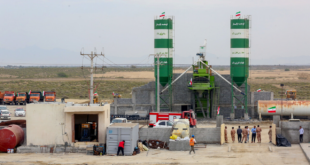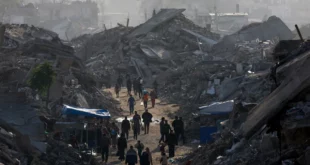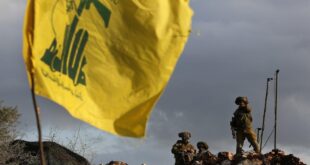Samer recalls the gruesome shock of seeing his friend’s headless corpse strung up above Raqqa’s main square.
It’s this memory, from a hot summer day in 2015, that defines his time living under ISIL’s rule in Syria.
“No one was allowed to touch it, nor bring it down for a proper burial,” Samer says of the body of his friend, an English literature graduate in his mid-20s who was killed for his “activism”.
“I can’t describe what I saw, simply because there are no words to describe it,” adds Samer, who uses a pseudonym to protect his identity.
“I fainted in the middle of the crowd and was immediately taken away.”
Public executions were a regular occurrence in ISIL’s former self-proclaimed capital – a brutal tactic aimed at silencing dissent and striking fear into the population.
At its peak in January 2015, ISIL covered an area across Syria and Iraq roughly equivalent to the size of the UK and attracted 40,000 foreign fighters to its cause.
On Saturday, US-backed fighters in Syria’s east have declared their final victory over ISIL, ending a four-year battle against the group’s territory.
An official of the Syrian Democratic Forces (SDF) announced the group’s defeat in Baghouz, a town in Syria’s Deir Az Zor province that represented ISIL’s final holdout.
Yet the fall of Baghouz will likely not mark the end of ISIL as a force in the region, analysts say.
According to Joshua Landis, director of the Center for Middle East Studies at the University of Oklahoma, “hit-and-run” attacks executed by ISIL sleeper cells are going to persist in both Iraq and Syria.
As such, “ISIL is far from being destroyed as a terrorist organisation,” Landis adds.
Emerging in Iraq, sprawling into Syria
ISIL began as an offshoot of al-Qaeda in Iraq, which in 2006 became known as the Islamic State of Iraq (ISI). The movement, led by key al-Qaeda figures, played a major role in driving the sectarian conflict that followed the US invasion in 2003.
ISI carried out deadly attacks in the Iraqi capital, Baghdad, during this period, targeting Western-allied tribal leaders and US army posts before eventually being pushed out.
Undeterred, it soon pitched up in Mosul, Iraq’s second-largest city, which it then used as a hub to continue its attacks.
In 2010, the group’s current leader Abu Bakr al-Baghdadi was named ISI chief. Two years later, he mandated ISI affiliates to set up an offshoot in Syria – a country that had been forced to contend with its own civil war.
Members of that offshoot, first known as Jabhat al-Nusra, were then integrated into ISIL after a number of defections.
ISIL quickly began to establish its presence over drained, vulnerable, war-torn areas in Syria and Iraq, making it easy for the group to gain both influence and military power.
Meanwhile in Raqqa, ISIL worked on weakening the Free Syrian Army (FSA), which opposed forces loyal to Syrian President Bashar al-Assad. It eventually ejected the two largest FSA factions at the start of 2014.
“ISIL creeped up on us,” Mostafa Sager, a former FSA fighter who lived under ISIL’s rule, told Al Jazeera.
“They worked in secret and relied on spies to weaken the FSA who were busy fighting the regime,” the 27-year-old, who remained in Raqqa until the summer of 2015, said.
‘Not a utopia’
At its onset, ISIL began asserting its power “aggressively”, Sager, who had discreetly surrendered to the group following the FSA’s removal, says.
He recalls how he quickly felt like a stranger in Raqqa.
The faces of foreigners, mostly Europeans, Chechens and North Africans, soon flooded the streets while all signs of the Syrian revolution – which Sager refers to as the “golden era” – were painted over and erased.
The self-proclaimed caliphate promised its supporters a utopia while human rights violations by Assad’s government and FSA factions continued to mount.
Sager says that some chose to support the group in its early stages because they were seeking “justice and freedom” from the war and from Assad’s “shackles”.
In addition to political exclusion and rights abuses, poor economic conditions and unemployment also contributed to the rise of ISIL.
This is why ISIL has been a “great success as a protest movement,” Landis, the professor, noted. “It has been able to mobilise hundreds of thousands, win the sympathies of even more and become a movement that is feared the world over.”
Over the years, several armed groups outside the Middle East, including in parts of Africa and Southeast Asia, have pledged allegiance to ISIL, claiming attacks on both civilians and security personnel.
The United Nations in 2016 revealed that at least 34 groups from around the world had pledged allegiance to the so-called “caliphate”.
Individual attacks have also taken place in the name of ISIL, including incidents of mass shootings in the United States and Europe.
Yet, in the middle of a turbulent war, ISIL’s attempts to create its own society have proven unsuccessful.
“They (ISIL supporters) thought they were getting a clean, non-corrupt entity to replace the central government,” Bessma Momani, professor of political science at the University of Waterloo, told Al Jazeera.
“But they soon learned this was a medieval-style organisation that ruled by way of fear,” she says. “This was no liberation, and it was not a utopia.”
‘This is not Islam’
The group’s infamous tactics left many with no option but to conform as a means of escaping harassment, arrest and death.
While men were prohibited from shaving off their facial hair, ISIL’s religious police, the Hisbah, forced women to cover their faces.
“The Hisbah would especially harass women if they weren’t wearing the ‘right clothing’,” says Samer, who wrote The Raqqa Diaries, a first-hand account depicting his experiences living under ISIL.
Life under the group also meant limited contact with the outside world. Internet cafes were monitored, television sets were banned, and owning a mobile phone suggested conspiring with “foreign agents”.
“It was as if the walls had ears,” Samer says, describing life under scrutiny.
As the situation deteriorated, both Sager and Samer felt compelled to do something.
“We had to wake people up and show them that this was not right, this is not Islam,” says Samer, who fled to Turkey in 2017.
While Samer wrote witness accounts, Sager managed to smuggle a small, button-sized camera lens into Raqqa to secretly document daily life under ISIL rule – some of the footage he captured, which included public executions, was later used in international media reports.
The two men recall how the group’s targets had always been “helpless civilians”, as Samer puts it.
“Whenever they felt like they were about to lose territory, they’d tighten their grip and project onto civilians,” he says.
This was the case when a US-led coalition began battling ISIL in Iraq and Syria. Only months after Baghdadi declared the establishment of the self-proclaimed cross-border caliphate in Mosul in 2014, the group was being targeted by coalition air raids.
Yet it continued to spread further into Kurdish controlled territory in northern Iraq, where they enslaved minorities, including members of the Yazidi community.
Relentless aerial bombardment, coupled with ground incursions by coalition allies, eventually led to the demise of ISIL as a self-proclaimed caliphate – but it came at a huge cost.
According to Airwars, a UK-based group tracking allegations of civilian casualties, coalition air raids amounted to at least 6,000 civilian deaths in Iraq and Syria because of fighting in densely populated urban areas.
The monitoring group told Al Jazeera the total number of coalition air and artillery strikes between August 8, 2014, and February 23, 2019, amounted to 33,961 attacks.
Most of those raids were in Syria, largely because of the campaign to capture Raqqa.
What’s next for ISIL?
Despite being defeated in terms of territory, analysts say ISIL’s ideology will live on.
Columb Strack, senior Middle East analyst at IHS Markit, says ISIL is already “reorganising to establish safe havens in near-inaccessible areas in Iraq’s Sunni heartland by rebuilding networks of support in surrounding sympathetic Sunni Arab communities”.
This will likely be the case in neighbouring Syria as well, where the US has said it is preparing to withdraw its troops from the country’s northeastern region.
Analysts, including Momani, the professor at the University of Waterloo, believe that a return of foreign ISIL fighters to their home countries is key to the prevention of a future resurgence.
Hundreds who have surrendered to the Kurdish-led SDF in Baghouz over the last few weeks are foreign fighters, a spokesperson for the Kurdish militia previously told Al Jazeera.
But there appears to be a reticence for originating countries to take back citizens who left to fight for ISIL.
Last month, US President Donald Trump demanded his European allies “take back over 800 ISIS fighters we captured in Syria and put them on trial” – a call rejected by countries, including France and the UK.
With such risks still in place, people like Samer, who lost his father to a coalition air raid, say they have no other choice than to remain in exile.
He says ISIL’s takeover was a “stab in the back”, and through his diaries, wanted to show the world that ISIL and Assad’s government are “two sides of the same coin”.
“When Assad’s forces were pushed out, we lived a golden era,” he said, reminiscing about the early days of the Syrian uprising.
“The feeling of freedom was indescribable … it’s what I miss the most.”
 Eurasia Press & News
Eurasia Press & News



